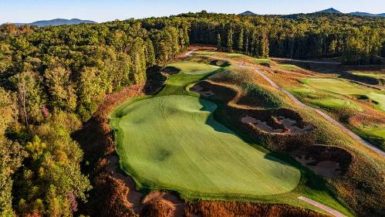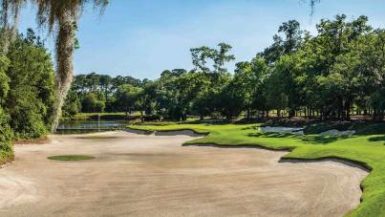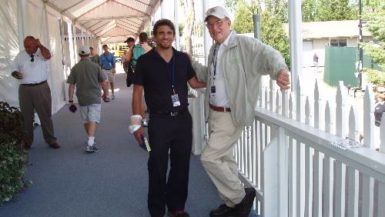TPC SAWGRASS (STADIUM)
110 TPC Blvd.
Ponte Vedra Beach, FL 32082
904.273.3235
www.tpc.com
Architect: Pete Dye
Par 72
Excitement Level – 12/12
Difficulty – 12/12
Design – Seven stars
Natural Setting – Four and 1/2 stars
Conditioning – Seven stars
Cost – $300 peak, $160 reduced
Yearly Memberships –
Value – Seven stars
Overall – Seven stars
Tees Yards Rating Slope
TPC 7001 75.0 149
Blue 6514 72.3 139
White 5815 69.0 130
Red 5034 65.3 125
Dramatic moments in golf history are written every year at the Player’s Championship, deservedly known as golf’s “fifth major” and played annually on a stage second only to Augusta National in terms of both history and public recognition. A watershed moment occurred in the golf world in 1978 when the PGA tour purchased 415 acres of desolate swampland near Jacksonville, Florida for one dollar. Tour commissioner Deane Beman hired architect Pete Dye and gave him a mission that would change both golf course design and tournament venues forever. The challenge was to build a course that would host not just any tournament, but the Players’ Championship, the annual championship for the touring professionals. Not only would the course have to challenge the best golfers in the world year in and year out at a high profile tournament, the course would also be the first “stadium” style golf course, featuring natural grass amphitheatres around greens and enormous mounds flanking the fairways to seat spectators.
Dye went much further. In designing his archetypal fan, media and player favorite, he spawned an entire generation of target golf courses throughout the world and gave birth to a nationwide network of stadium courses designed for tournament play and spectator accommodation. In this regard, Dye’s achievement at Sawgrass is underestimated, for although years of copycat courses mimicked target style shot requirements, Sawgrass is rich with risk-reward options and strategic subtleties. Sure everybody knows the dramatic, all-or-nothing 17th, but there are many other holes at Sawgrass that provide equal doses of drama, shotmaking requirements, course management and patience.
The significance of Dye’s achievement in designing Sawgrass cannot be overstated. Without question, Sawgrass is the most important course built in this country between Pebble Beach (1919) and Bandon Dunes (1998). Harbour Town heralded the arrival of the Dye era and Whistling Straits may be his artistic masterpiece, but Sawgrass is Dye’s greatest contribution to the history and architecture of the game. Sawgrass is fun for everyone – the media, the fans and even the players. Indeed, the wild popularity of the course with spectators and TV viewers helped trigger an entire trend in golf course architecture and spawned over twenty more TPC facilities. Often imitated, but never equaled and now universally revered, the Stadium course is a shrine to the game itself, a Mecca to all true players and fans, and is one of the game’s most recognized and celebrated icons. For all his great designs throughout the world, Dye may best be known for Sawgrass.
Strangely, it took a lucky bounce from fate for any history to have been written at all. When the first tournament was held at Sawgrass in 1982, the players’ criticism was searing. “Unfair,” “carnival golf,” “screwy,” and “the only thing missing is the clown’s nose” were just a few of the grouses snarled by the best players in the game. J.C. Sneed famously quipped “they messed up a perfectly good swamp….It’s 90% horse manure and 10% luck.” But over time and with a few subtle changes, the players have come to embrace and love Sawgrass as the unique jewel in golf’s crown that it is. The fans get to watch the pros under white-knuckle pressure, the media gets dramatic, all-or-nothing shot values and visitors get to try their hand at one of the golf world’s most blessed plots.
Oh yeah, and then there’s 17, probably the single most recognizable hole on Earth. With its island green lying in the middle of the lake, even casual golf fans who see an aerial shot of the hole know exactly what and where it is. At a maximum length of 145 yards and playing a mere 120ish for amateurs, it seems merely a smoothly swung short iron, maybe even a wedge. The challenge could not be stated more simply – “Here’s the tee, here’s the green, hit the ball.” But there is no room to bail, nowhere to hide, nowhere to run. A watery dooms lurks on all sides. Hit the green and hold or reload. It’s hero or zero. And when the wind kicks up on that hole, forget it! Some tour players call it the best hole on tour. Golf writer Brian McCallen called 17 “a pint-sized Titanic to sink your scorecard.” Indeed, no scorecard is safe until the player negotiates 17 and knees do knock, hands do shake, stomachs do knot, and hearts leap into throats. Fans and TV executives love the hole as it provides drama at all times. An entire website has been devoted to allowing fans to watch every shot played to the hole on all four days of the tournament. Amateurs and pros alike go through the same pressure standing over that shot. Roughly 120,000 golf balls per year are pulled out of the pond at the 17th. It’s the eyes of an alligator lurking just above the surface of the water, watching its prey – your scorecard and your ego – and waiting to gnash, rend and shred. (One could, of course, make par the hard way as your author did, double-crossing his tee shot onto the 18th tee then flopping a wedge onto the green and rolling in the 15 footer. On my first attempt on the course no less.)
Sawgrass’ tournament history is deservedly rich and fan friendly. After winning the first tournament held at Sawgrass in 1982, Jerry Pate (with his orange golf ball) jumped into the lake on 18 and then, to the delight of the fans and other players, dragged in Deane Beman and architect Pete Dye. Nicklaus won at Sawgrass. Tiger won in 2000 after sinking a slick, twisting fifty foot putt across the 17th green. Popular pro and Ryder Cup Captain Hal “Be The Raaaaaght Club To-Day!” Sutton won twice at Sawgrass. From Adam Scott’s improbable up and down after seemingly blowing the tournament by hitting his approach on 18 into the water, to Craig Perks’ unbelievable eagle-birdie-par double chip-in finish to seize the 2002 championship, Sawgrass has provided compelling theatre in a setting unique in the entire golf world. Are you entranced by the heroic nature of the 17th? Fred Couples has had several adventures there, like his famous “hole in 3” where he held out at the teebox after hitting his original shot in the water. Do you like charging finishers on Sunday afternoon? “We got run over by Davis” laughed Jay Haas when Davis Love shot his incredible final round 64 in 2003. Love won by six shots and carded a blistering 31 on the back 9, including five consecutive birdies. Most impressive of all, he did it in the rain and wind. The rest of the field played the course in an average of 74 strokes, ten shots worse. Some players called it the best single round of golf they ever witnessed.
Best of all, for an amateur, playing Sawgrass’ Stadium course is one of the richest experiences a player can ever have. You can’t ride a horse at Churchill Downs, you can’t catch a pass at the Rose Bowl, you can’t take batting practice at Fenway Park, but you can play the Stadium course and walk in the spike marks of the world’s greatest professionals. The excitement in playing a course that the best golfers in the world once thought was unfair and which now is regarded as one of the greatest venues in all of sports is a seminal experience in the career of any golfer.
ON THE COURSE
In this age of drivers the size of houses, coefficients of restitution, and super long golf balls, is it still possible for a course under 7000 yards to prove a competitive challenge to the game’s best? Surely such a course could never beguile, bedevil and frustrate the zen masters on the PGA tour. Surely such a short layout would wither and succumb to the surgical precision of our magic producing Sunday heroes and their cannon length drives.
Guess again. 2004 was the first year the distance clocked in at over 7000 yards for the pros. Instead, this true target golf course requires careful concentration and course management on every shot. This is not a course that can be overpowered with a driver as the penalty for any missed shot is bogey or worse. Dye’s philosophy in designing this course for pros playing in a marquis event was “they can’t recover from water.” Dye is right. With its penal nature, pros hate a water hazard just as much as weekend golfers. Accordingly, there is water present on every hole (although not always in play) and Dye’s intimidating water hazards, mounding and bunkering leaves little room for error.
Sawgrass is also a showcase of all the great design features Dye has embraced and shared with the golfing community. Severe mounding, bulk-headed water hazards, pot bunkers and staggered tee boxes (his wife Alice places the ladies tees now, usually well in front of the trouble) and stadium mounding for spectators, are all hallmarks of design features he returned with from the British Isles. These classic aesthetic features are woven onto a design which is rich in strategic, risk-reward options. Reachable par fives are guarded by menacing water hazards. Short par fours are strengthened by false front greens, penal bunkers and devilish collection areas. Shot requirements are varied, keeping the player off balance. One minute the course calls for a draw, then later a fade. One hole is short, the next long. And at all times Sawgrass demands a wide range of creative shotmaking and a wealth of patience. The course is not long so smart players who hit their targets all day will actually leave with a respectable score.
Players must get their scoring done early as the first three holes on each nine offer the best chances for birdie. Interestingly, the first hole and tenth hole are identical except for the fact that they are reverse images of each other. As professional tournaments frequently will send players off the first and tenth tee for the first two rounds, Deane Beman instructed Dye to make the starting holes very similar so that the pros would be faced with similar challenges no matter which hole they began the tournament on. They even have the same hazards at almost exactly the same distances. They are both short par 4s, the first hole with water and sand to carry off the tee, bends gently to the right. The 10th hole with water and sand off the tee, bends gently to the left. Both two and eleven are short reachable par 5s and offer great birdie chances for the professionals and long hitters. Amateurs must still stay straight as trouble lurks right in the form of water, sand and trees.
The course begins in earnest at 4, a classic Dye risk reward par four with a severely canted green. While barely over 300 yards, danger lurks everywhere as the second shot must be played over water to a green which slopes off on all sides. Placement is paramount here as the tee shot must be played to the correct side of the fairway to offer the optimum approach to the green. Even pros, who should escape unscathed, have considerable trouble since the approach drops off into the water so sharply. Bunkers in back of the green will catch approaches that are too bold and both puts and chips from the high side risk running back into the creek.
Five, six and seven are each par fours. They were designed long, short long, to keep the pros off balance and provide variety in the design. The eighth hole, the longest of the par 3s, clocks in at over 200 yards and is completely surrounded by bunkers. It perennially plays one of the toughest holes on the course. The par 5 ninth is a genuine three shot par 5 that jumps over a creek and then swings hard left to a green nestled below a dell of mounds and trees. The very small green is designed to accept a wedge shot, but many players miss and walk off mumbling about missing a birdie opportunity.
Like the front, get your scoring done early on the back. 10, 11 and 12 are a relatively short par 4, 5 and 4 respectively. Eleven is reachable in two by many, but water and sand protect par admirably. On twelve, Dye baits you to hit driver to avoid having a semi-blind shot in to the green. Again accuracy is more important. While shorter safer shots will have to be played semi-blind, errant shots from a driver will end up with fully blind approaches.
The pressure level surges at 13, which if it were not overshadowed by its sister at 17, would be recognized in its own right as one of the best holes in the country. A short par 3, water runs all the way from the teebox to the green, which is set in an idyllic dell of tall trees. Again a severely canted green helps defend par admirably. 14 and 15 are demanding par 4s, both over 400 yards. Like the first hole, 14 plays right to left off the tee, then left to right on the approach – an old Donald Ross staple of design and a favorite of Dye as well who likes to keep the player off-balance with varied shot shaping requirements. Keeping the player further off balance, 15 plays left to right of the tee, then right to left into the green. This gives Sawgrass the strategic feel of a rumbling shotmaking roller-coaster.
The 16th is a great risk reward par 5, as it can be reached in two, but the penalty for balls hit to the right, is the water. It is the best chance to get a stroke back on the closing stretch. Players are meant to go for it in two, but if a player lays up, it’s a tough pitch since green slopes toward water.
Playing along the 16th, no professional or amateur can resist taking a peak at the challenge lying ahead of them – arguably the most celebrated par three in the world. The fickle Florida winds can change from moment to moment and even swirl, making the hole as unpredictable as the twelfth at Augusta. Rarely does a leader come to 17 with a bulletproof lead. While, interestingly, no leader on Sunday that has put one in the water on 17 has ever lost the tournament, the mere possibility of epic meltdowns adds to the allure of the hole to the fans and media. Happily, for amateurs, they never have to play the hole with the green as fast and firm as the pros.
The par 4 eighteenth is a fabulous finishing hole that Dye has copied on many other courses. At 420 yards, this cape-style hole that bends hard left it is a stern finishing test and offers a summation of all that Sawgrass is, narrow, watery, penal and demanding of both concentration and execution. Water guards the entire left side of the hole. Shaggy heaving mounds guard the right side of the hole on the approach. A difficult four for any player, touring pros even tighten up. Adam Scott provides a stellar example. With a two shot lead on the 72nd hole, he double-crossed a six-iron into the water. His incredible up-and-down from well off the green preserved his win, but illustrates how eighteen can hand out drama as well as its more high-profile sister by which it is preceded.
CHIP SHOTS AND TAP-INS
Sawgrass is a final examination in golf, an all-around test of a player’s entire game and course management skills. It was designed for a pro tournament with the pros in mind. It remains reasonably playable for the resort guest as well, but that’s secondary. People still come. They see it on TV and have to try for themselves. For touring pros and single digit handicappers, Sawgrass’ subtlety adds the most magic to the experience. Like Augusta National, when the irons shots are accurate, the ball will funnel to the hole and when shots are inaccurate, they repel because they will bounce off the wrong side of the slopes. Amateurs must play Sawgrass conservatively. They also should not be intimidated or distracted – easier said than done.
Although the greens fee frequently tops $250, Sawgrass is actually and excellent value. The course is always in tour condition, the design is one of the best in the world, and the amenities make players feel as though they are tour members for a day. The state-of-the-art clubhouse is a shrine to the tournament, but also boasts replicas of many trophies awarded at various tournaments played all around the country. The portrait of every Player’s winner graces the clubhouse walls. Even the practice facilities are pristine.
Most guests must stay at the Sawgrass Marriott in order to secure a tee time. In low season, Sawgrass can be played for as little as $160. Play over the New Years holiday and you will have the course to yourself.





Ahem: 18 holes. 365 days. 12 months.
FOUR majors.
Great article…!
[…] Here’s an article on Sawgrass. I wrote it prior to the changes to promote firm and fast play. […]